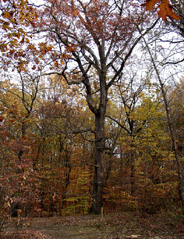 |
#1 Forests
of two markedly different ages are visible from here. To the south
(facing the post) is an older
woodland composed of a considerable diversity of t ree
species and sizes. The largest tree, a white oak just behind this
marker, is 95 feet high and is 190 years old. To the north is a
much younger woodland,
with shorter, thinner trees, many of which are less than 30 years
old. Red maple dominates this young forest, although a few silver
maple, river birch and chokecherries are also visible. These two
forest types reflect past land use. Before UMBC was founded in 1966,
the young forest to the north was likely an abandoned agricultural
field, dominated by grasses and wildflowers. Gradually, shrubs and
young trees began to grow and shade the site, replacing the herbaceous
plants. This sequential change in plant species over time is known
as succession. The forest to the south is a much older successionary
stage. It has been a wood lot since the early 1900's, although the
scattered nature of large trees indicates the forest may have been
open to grazing in the first half of the twentieth century.. ree
species and sizes. The largest tree, a white oak just behind this
marker, is 95 feet high and is 190 years old. To the north is a
much younger woodland,
with shorter, thinner trees, many of which are less than 30 years
old. Red maple dominates this young forest, although a few silver
maple, river birch and chokecherries are also visible. These two
forest types reflect past land use. Before UMBC was founded in 1966,
the young forest to the north was likely an abandoned agricultural
field, dominated by grasses and wildflowers. Gradually, shrubs and
young trees began to grow and shade the site, replacing the herbaceous
plants. This sequential change in plant species over time is known
as succession. The forest to the south is a much older successionary
stage. It has been a wood lot since the early 1900's, although the
scattered nature of large trees indicates the forest may have been
open to grazing in the first half of the twentieth century.. |
|











